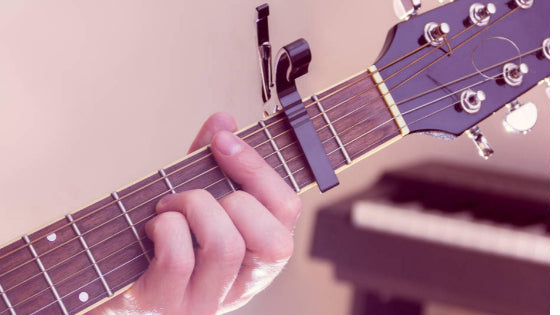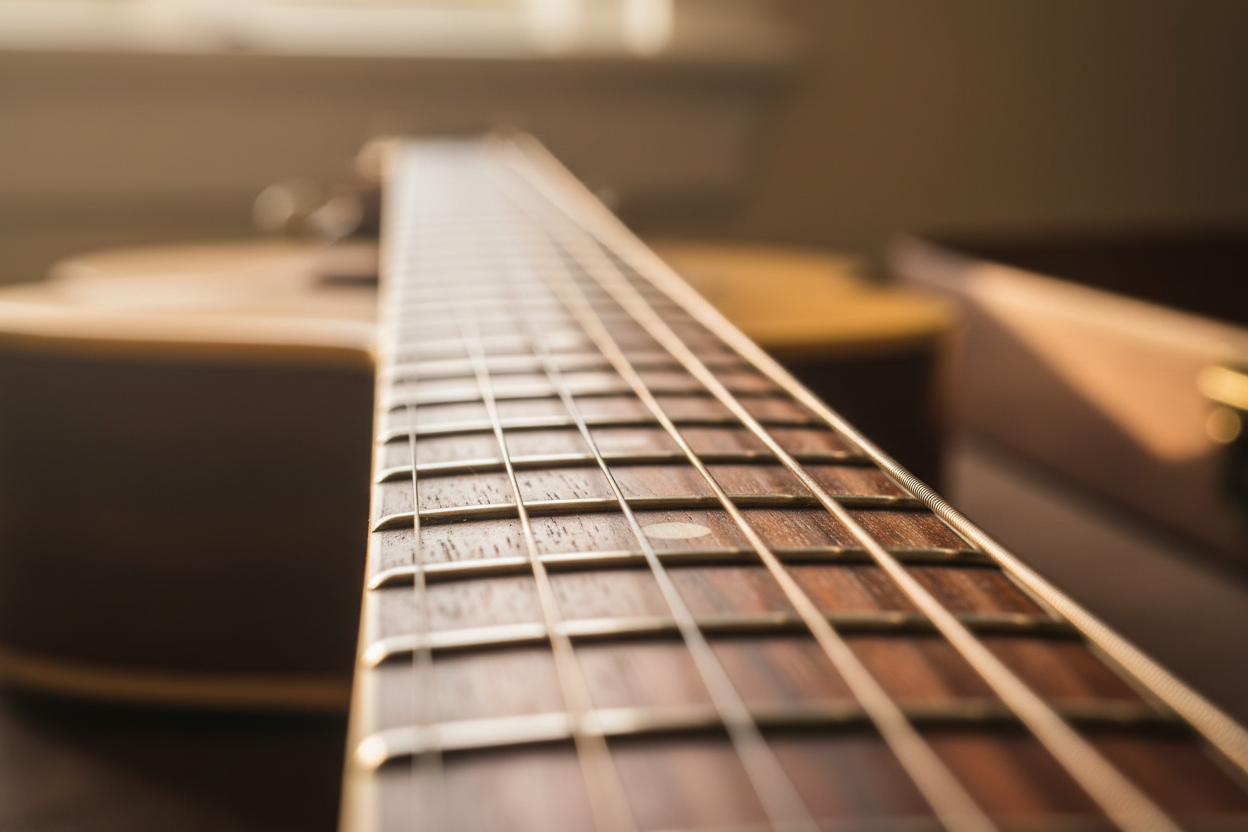Using a Guitar Capo: A Beginner's Guide
Did you know that a guitar capo can make learning open guitar chords easier? If you have never used a capo before, it is designed to allow a guitarist to play open-shaped chords in different keys.
For example: If you play a G chord in the open position, the notes produced will be G-B-D. However, putting a capo at the second fret and playing that same G shape will make an A chord. The capo acts as if it is the guitar's new nut, shortening the length of strings and raising the pitch, thus allowing you to play open-shaped chords all over the neck.
A capo is great for playing songs in different keys with the same set of chord shapes. It also produces a beautiful tone and can put a different spin on any song.
But, there are three unintentional benefits for beginners that a capo can offer. First, let's go over some of the challenges that a novice guitar player faces and then discover how a capo can help overcome them.
Many beginner guitarists struggle with getting the correct hand posture to play a guitar chord. As a result, their chords suffer dead notes, muffled sounds, or fret buzz from poor technique.
Part of the problem is the player's hand is not conditioned yet. As a result, the player does not have adequate finger strength, flexibility, or calloused fingertips that help notes ring clearly.
The unconditioned hand also experiences pain. The fingertips are tender and can blister easily after extensive practice.
Three Benefits of a Capo for the Beginner Guitarist

1. Better String Action
The capo can help make playing guitar easier. It clamps down on the strings, which improves the action. It takes less force to squeeze out the notes of your chords when a clamp is already doing some of the work for you. You also do not have to contend with the extra pressure it takes to fret a note next to the guitar nut.
The F chord can demonstrate this well. This chord can be painful to learn, as it simply hurts your hand and fingers at the beginning of your guitar-playing journey.
New players struggle to get the notes on the 1st and 2nd strings of the F chord to ring clearly. Because both notes, F and C, are barred with the first finger, it takes a lot of pressure to get those notes to ring out nicely.
Try placing a capo at the second fret and then play the F-shaped chord. Easier, right? The capo is assisting by lowering the action. It now takes less force and is less painful to play any open position chord.
2. Increased Space Between Strings
You gain more string spacing as you ascend the guitar neck. New guitarists struggle with hand posture and often find their fingers accidentally touch adjacent strings, causing them to mute.
Try placing a capo behind the 3rd or 5th fret, or whatever fret feels most comfortable for you. The guitar neck gets wider as you travel towards the guitar's body, making it easier to fit your fingers between the strings with the increased string spacing.
Once you have mastered playing a chord at the fret of your choice, you'll want to reposition the capo to the next fret down towards the headstock and begin training your hand in the new position. Gradually, the string spacing narrows as you work your way down the neck, but it becomes more manageable as you train your hand.
Your hand only has to make minor adjustments for each fret change. Each new fret position is met with more experience, muscle memory, and skill. Before long, you will have mastered your chords in the open position.
Practice tip: Learn two chords at a time. When you switch back and forth between two chords, it will help develop your muscle memory faster. This practice method is sometimes referred to as chord snapping or chord flipping.
3. Decreased Space Between Frets
As you travel up the guitar neck, the spacing between the frets gradually reduces. As a result, open position chords played with a capo will be easier for beginners or people with small hands.
A novice guitarist may not have the flexibility to stretch their fingers into the required positions for some chords. It can be painful and exhausting.
With a capo, you can find that sweet spot on the guitar neck that does not overstretch or hurt your hand. Again, when training with the capo, keep moving it down the neck one fret at a time as you master each position. This will gradually stretch and condition your hand. Each position will be easier to learn than the last as you bring more skills and experience to the table.
Conclusion
Using a capo as a training tool is very helpful for beginner guitarists. It takes less effort to master open chord shapes.
Three instant training benefits of a guitar capo are:
- It's easier to press your guitar strings.
- You have more space between strings for your fingers to find their positions.
- You don't have to stretch your hands as much to reach notes.
We could also say that there is a 4th benefit—less pain.
When you make guitar playing less painful, you'll enjoy practicing more, and you'll reach your goals faster.
It should be noted that using a guitar capo past the 12th fret can make playing more difficult. The fret spacing gets too narrow to comfortably play chords.
Once you get used to playing with a capo in different positions, you might be interested in learning songs that use a capo, such as Hotel California, Wonderwall, Free Falling, Fire and Rain, Landslide, Norwegian Wood, the Sound of Silence—the list goes on! There are so many great tunes recorded with a capo.
We hope this article has been insightful for you. As always, if you have any questions, just ask; we are here to help. And if you know of any guitar players that could benefit from this knowledge, please share it with them. Happy playing!




